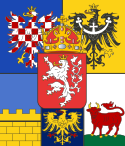Czech Crown lands
| Lands of the Bohemian Crown | ||||||||||||||||||||||
|
Země Koruny české (cs) Länder der Böhmischen Krone (de) Corona regni Bohemiae (la) |
||||||||||||||||||||||
|
States of the Holy Roman Empire (1348–1806), Crown lands of the Habsburg Monarchy (from 1526), |
||||||||||||||||||||||
|
||||||||||||||||||||||
|
||||||||||||||||||||||
|
Lands of the Bohemian Crown within the
Holy Roman Empire (1618) |
||||||||||||||||||||||
| Capital | Prague | |||||||||||||||||||||
| Languages | Czech, German, Latin | |||||||||||||||||||||
| Religion |
Roman Catholic, Utraquist, Lutheran, Bohemian Brethren, Moravian Brethren, Anabaptist, Jewish |
|||||||||||||||||||||
| Government | Monarchy | |||||||||||||||||||||
| King | ||||||||||||||||||||||
| • | 1346–1378 | Charles IV (first) | ||||||||||||||||||||
| • | 1916–1918 | Charles III (last) | ||||||||||||||||||||
| History | ||||||||||||||||||||||
| • | Bohemian Crown established | 7 April 1348 | ||||||||||||||||||||
| • | Inauguration of the Luxembourg dynasty |
7 April 1348 | ||||||||||||||||||||
| • | Became main part of Bohemian Crown lands |
5 April 1355 | ||||||||||||||||||||
| • | King confirmed Elector | 25 December 1356 | ||||||||||||||||||||
| • | King Ferdinand I, Holy Roman Emperor | 16 December 1526 | ||||||||||||||||||||
| • | Dissolution of Austro- Hungarian Empire |
31 October 1918 |
||||||||||||||||||||
|
||||||||||||||||||||||
| Today part of | ||||||||||||||||||||||
Crown lands of the Habsburg Monarchy (from 1526),
of the Austrian Empire (1804–67),
and of the Cisleithanian part of Austria-Hungary (1867–1918)
The Lands of the Bohemian Crown, often called Czech lands in modern times, were a number of incorporated states in Central Europe during the medieval and early modern periods connected by feudal relations under the joint rule of the Bohemian kings. The crown lands primarily consisted of the Kingdom of Bohemia, an electorate of the Holy Roman Empire according to the Golden Bull of 1356, the Margraviate of Moravia, the Duchies of Silesia, and the Lusatias, as well as other territories throughout its history.
The joint rule of Corona regni Bohemiae was legally established by decree of the Luxembourg king Charles IV issued on 7 April 1348, on the foundation of the original Czech lands ruled by the Přemyslid dynasty until 1306. By linking the territories, the interconnection of crown lands thus no more belonged to a king or a dynasty but to the Bohemian monarchy itself, symbolically personalized by the Crown of Saint Wenceslas. Under the rule of Ferdinand I from 1526, the lands of the Boheman Crown became a constituent part of the Habsburg Monarchy. Later they passed to the Austrian Empire and the Cisleithanian half of Austria-Hungary. By the Czechoslovak declaration of independence in 1918, the remaining Czech lands became part of the First Czechoslovak Republic.
...
Wikipedia



